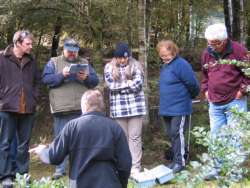Links between scientific and cultural indicators of river health
Research Status: Ongoing |
River health assessment |
Introduction
There is an increasing need for accurate and reliable information about our environment and also increasing recognition of the need to include different perspectives into monitoring programmes. The Resource Management Act (RMA 1991) emphasises the importance of the relationship of Māori with their environment and requires that decision makers have particular regard to kaitiakitanga and understand the Māori world view. Cultural indicators help to articulate cultural values, assess the state of the environment from a cultural perspective, and assist with establishing a role for Māori in environmental monitoring. In this work we review the philosophies behind cultural and scientific monitoring of river health and compare the results from the two approaches at sites where corresponding data is available.
Research Approach
Iwi/hapū groups from the Motueka Catchment have adapted a cultural health index developed in the Otago region and applied it at sites throughout the Motueka and Riwaka catchments. The Motueka cultural health index stratifies the landscape into Atua domains (a Māori cultural framework) such as Tangaroa, Tane Mahuta, Haumietiketike, Rongomatane, Tūmatauenga and Tawhiri Matea. Attributes covering riverbank condition, riverbed composition, water clarity, water flow, water quality, channel shape, riparian vegetation, catchment vegetation, river modification/use, use of river margins and smell are scored from 1 (poor) to 5 (excellent), with the overall cultural stream health measure calculated as the average of these scores. An assessment of the mahinga kai status and traditional status of the site is also determined, along with a judgement of whether iwi would return to the site.
Scientific monitoring of river health is also being conducted throughout the Motueka Catchment and many of the sites overlap allowing a comparison of the results from the two approaches.
Research Results
There was considerable overlap in site selection between the scientific and cultural health monitoring efforts, with the few differences reflecting the differing objectives of each monitoring programme. There was a strong correlation between the cultural stream health measure and the percentage of the catchment above each site in native forest, and also weaker relationships with water clarity, a macroinvertebrate community index (SQMCI), and the concentration of faecal indicator bacteria. These relationships confirm that both types of indicators are successfully capturing aspects of river and stream health. When comparing guidelines associated with the scientific data it was apparent that the cultural stream health assessments were more strict than stream health standards based on scientific data.
The scientific approach is robust and objective and uses methods and equipment that are well tested and reviewed. Scientific methods measure precise changes to river and stream health over time but can be relatively costly and require a high degree of professional expertise and experience. The cultural approach is qualitative, cost effective and based to a high degree on acquiring in-depth knowledge of a local environment (e.g., mātauranga Māori, local and historical knowledge). Cultural methods rely on collective skills/knowledge held by tangata whenua and a high degree of consistency in the assessment in order to measure and detect long-term changes to an environment. Scientifically based and culturally-based indicators, along with community-based approaches, potentially provide an enriched understanding of the environment with each offering a slightly different worldview about the health of freshwater systems. With this complementary model, different forms of assessment and monitoring can be used side by side by local government, community, iwi and hapū, and research agencies. No particular group is excluded from working across a range of assessment types although a certain level of expertise and specialist knowledge is required for each.
Recent Publications
Primary Contacts:

|
Garth Harmsworth
Email More details» |
Institute Landcare Research |
Expertise environmental planning, Maori research, Maori issues, land resource assessment, GIS applications. |

|
Trevor James
Email |
Institute Tasman District Council |
Expertise Water Quality and Aquatic Ecology |

|
Dean Walker
Email |
Institute Tiakina Te Taiao Ltd |
Expertise Resource Management/ Kaitiakitanga, Geographic Information Systems, Indigenous Forest Management |

|
Roger Young
Email Phone: (03) 548 2319 Fax: (03) 546 9464 |
Institute Cawthron Institute |
Expertise Land/water interactions, water quality, fisheries, river health |